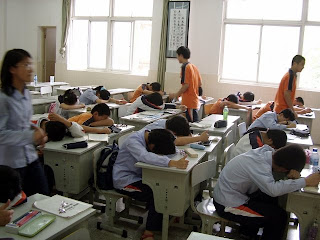 |
| Photo by goldberg (some rights reserved) |
1. The daily classroom schedule had "gym" listed instead of physical education.
This seems like a small thing, but the connotation for "gym" is that it's for playing while phys ed is more formal. Perhaps if everyone called it phys ed there would be a greater focus on the planning and relationship to curriculum.
2. The itinerant teacher who taught phys ed also taught indigenous studies. Twice a week she had indigenous studies and phys ed back to back for a total of 75 or 90 minutes. If the students were not listening in indigenous studies she would take away some of the phys ed time.
Is it ever appropriate to use the threat of eliminating one subject as a classroom management tool?
Will students who don't like phys ed act inappropriately "on purpose" to limit time in the gym?
3. Before the students went to their phys ed class the teacher told them they should do three laps then sit around the centre circle.
Why would we ask students to run a distance rather than a duration? Some students will be done very quickly while others struggle. Some students will walk the whole time just to delay the rest of the phys ed class.
4. The phys ed teacher did not have a whistle, music or other signal as a classroom management tool and relied on her voice.
Is yelling over the buzz of running students the most effective classroom management tool?
All of these routines created difficulty for me as I tried to teach one phys ed lesson.
I tried to use music as a tool for classroom management, but the students were not used to the music so they kept moving and talking even after the music had stopped.
I asked students to move freely in the gym, but many fell into the trap of running behind someone, often in a circle around the gym.
I tried to engage students in leading the class in stretches, but no one in the class could demonstrate a stretch for me.
I tried to do a variety of activities that would tie to the curriculum (moving as various animals and people, balancing on different parts of the body, a variation of rock/paper/scissors), yet every time I wanted to change the activity the students asked if we could play line tag or some other common "gym game".
I tried to get everyone up and moving and engaged, but one student said "Ms. X lets us sit out".
I know that I will do things differently when I am a classroom teacher because physical education is so important to me. I know that it is important to follow the curriculum, but I also think curriculum helps to provide guidance on ensuring students build on previous skills. Classroom management is often a challenge for phys ed teachers, but by establishing routines and expectations early it is not such a struggle to keep kids' focus.
I am glad I got the opportunity to teach one phys ed lesson, but I would have appreciated doing 3 or 4 to start to develop my own routines and style of teaching for the gym.






